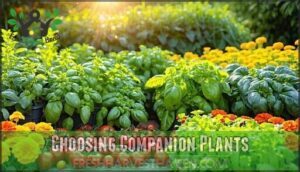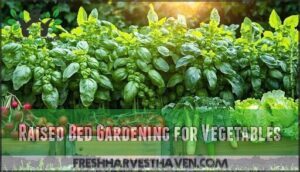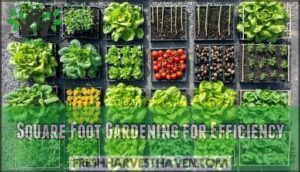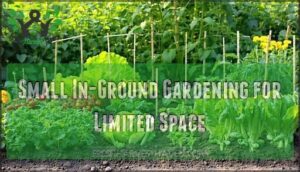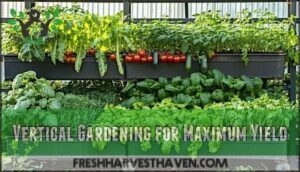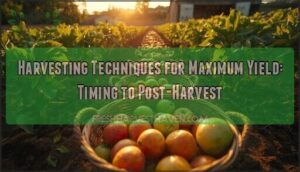This site is supported by our readers. We may earn a commission, at no cost to you, if you purchase through links.
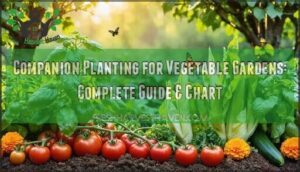
Think of it as setting up plant friendships that benefit each other. Tomatoes thrive with basil, which repels aphids while enhancing flavor.
Beans fix nitrogen for heavy feeders like corn, while nasturtiums act as trap crops for cucumber beetles. Marigolds emit compounds that deter nematodes, and their bright blooms attract beneficial insects.
Strategic placement maximizes these relationships—tall plants can shade heat-sensitive crops, while aromatic herbs confuse pests searching for their favorite vegetables. The key lies in understanding which plants complement each other’s growing needs and natural defenses, creating a system of natural pest control and improving soil health to ultimately boost yields.
Table Of Contents
- Key Takeaways
- Benefits of Companion Planting
- Choosing Companion Plants
- Planting Companion Flowers
- Garden Layout Strategies
- Avoiding Poor Plant Combinations
- Frequently Asked Questions (FAQs)
- What is companion planting?
- What is a companion vegetable garden?
- How do you grow a vegetable garden with a companion plant?
- What is a companion planting chart for vegetable gardens?
- What vegetables can you grow with a companion plant?
- Why is it beneficial to plant companion plants?
- Which vegetables should not be planted next to each other?
- What veggies pair well together?
- What vegetables to plant together chart?
- What are the best companion plants for vegetables?
- Conclusion
Key Takeaways
- Start with proven plant partnerships – You’ll reduce pest damage by 30% and boost yields by 10-20% when you pair tomatoes with basil, corn with beans, or carrots with onions instead of planting crops randomly.
- Use flowers as natural pest control – Plant marigolds and nasturtiums throughout your garden to deter harmful insects while attracting beneficial ones like ladybugs and hoverflies that’ll protect your vegetables.
- Avoid plants that compete for the same resources – Don’t plant heavy feeders like corn and tomatoes together, or crops from the same family that attract identical pests and diseases.
- Plan your layout strategically – Whether you’re using raised beds, square foot gardening, or row planting, map out your companion combinations before planting to maximize space and ensure proper plant spacing.
Benefits of Companion Planting
You’ll discover that companion planting transforms your vegetable garden into a thriving ecosystem where plants work together to solve common gardening challenges.
This strategic approach reduces pest problems by up to 30%, improves soil fertility through nitrogen-fixing relationships, and can increase your harvest yields by 10-20% compared to traditional single-crop gardening, which is a significant improvement in harvest yields.
Pest Deterrence and Control
When pests threaten your garden, companion planting offers powerful natural pest control without harsh chemicals.
Nature’s pest control works better than any spray you can buy.
Plant repellants like basil reduce tomato hornworms by 52%, while marigolds deter whiteflies by 80%.
Pest traps using nasturtiums divert aphids from beans, and aromatic herbs create crop barriers that confuse insects.
These biological controls work as effective organic pesticides, making your companion planting guide complete.
Attracting Beneficial Insects and Pollinators
The secret to thriving pollinator gardens lies in strategic companion planting that creates natural pest control systems.
When you plant bee-friendly flowers alongside vegetables, you’re building beneficial bug habitats that work around the clock.
These insect attractors don’t just look pretty—they’re your garden’s security team.
- Marigolds and calendula attract hoverflies that consume hundreds of aphids daily
- Borage and alyssum create pollinator attractants that boost fruit set by 25%
- Cosmos and native flowers provide pesticide-free zones for beneficial insects year-round
Improving Soil Fertility
Your garden’s soil becomes a living powerhouse when you harness companion planting for soil fertility.
Transform your garden into a living powerhouse through strategic companion planting partnerships.
Legumes like beans and peas naturally boost nitrogen levels through their root nodules, increasing soil nitrogen by 20% while reducing your need for synthetic fertilizers.
This nutrient cycling creates a self-sustaining system that keeps feeding your plants season after season.
Deep-rooted companions like sunflowers and comfrey improve soil aeration by breaking up compacted layers, allowing water and nutrients to penetrate deeper.
Meanwhile, diverse root exudates from herbs and flowers feed beneficial microbes, enhancing microbe balance and organic matter decomposition by 25%.
Soil Improvement Method Companion Plant Examples Fertility Benefit
Smart crop rotation benefits multiply when you incorporate cover crops between growing seasons, building soil health naturally.
Suppressing Weeds and Reducing Disease
Dense ground covers work as nature’s weed suppressors.
Squash plants create living mulch through their broad leaves, blocking sunlight that weed seeds need to germinate.
This weed suppression strategy eliminates hours of hand-weeding while protecting your soil health.
Nature’s ground cover does your weeding for you—squash leaves create a living mulch that blocks weeds before they start.
Companion planting improves airflow between plants, reducing fungal diseases by up to 25%.
Better air circulation prevents moisture buildup that fungi love.
Strategic spacing through plant companionship creates natural disease resistance without chemicals.
Certain plants exhibit allelopathic effects, releasing compounds that inhibit weed growth naturally.
These chemical signals boost soil health while providing crop protection.
This garden sanitation approach creates healthier growing conditions for your vegetables.
Increasing Crop Yields and Flavor
The right plant combinations can dramatically transform your harvest, turning an average garden into a productivity powerhouse. When you strategically pair vegetables with complementary companions, you’re activating nature’s own crop optimization system that boosts both quantity and quality.
Flavor Enhancement happens when aromatic herbs like basil release compounds that intensify tomato taste, while Yield Boosters work through nutrient synergy—beans fix nitrogen that heavy feeders like corn desperately need. Soil Enrichment from deep-rooted plants improves Nutrient Uptake for shallow-rooted neighbors.
These organic gardening methods prove that smart plant combinations outperform solo crops:
- Corn and beans grown together show 15% higher yields than single crops
- Basil planted near tomatoes enhances both flavor and pest resistance
- Marigolds boost tomato production while reducing harmful nematodes by 50%
- Sunflowers provide shade support, improving cucumber growth by 12%
Companion planting isn’t just folklore—it’s science-backed vegetable gardening tips that deliver measurable results in crop yield.
Choosing Companion Plants
You’ll want to select companion plants that work well with your specific vegetables and growing conditions.
Understanding which plants benefit each other helps you create productive partnerships that boost yields while naturally managing pests and improving soil health, which is crucial for naturally managing pests.
Tomato Companion Plants
When selecting tomato companions, choose plants that enhance growth while deterring pests.
Basil benefits tomatoes by repelling whiteflies and boosting flavor through aromatic compounds.
Plant companions create natural pest control systems that improve soil health and increase crop yield.
Understanding effective companion plant strategies is essential for a successful garden.
| Companion Plant | Primary Benefit | Impact on Tomatoes |
|---|---|---|
| Basil | Repels whiteflies, enhances flavor | 40% reduction in pest damage |
| Marigolds | Controls nematodes | 70% decrease in root damage |
| Borage | Attracts pollinators | 20% increase in fruit set |
| Garlic | Deters spider mites | Natural pest deterrence |
| Nasturtiums | Trap crop for aphids | Protects main crop |
These tomato pairings work through companion planting principles that support vegetable gardening success.
Follow these gardening tips for healthier plants and better harvests.
Companion Plants for Peppers
Pepper plants flourish with strategic companion planting that enhances their natural heat tolerance and growth.
Smart plant pairing creates a thriving ecosystem where each species supports the others through natural pest control and nutrient sharing.
Your pepper supports benefit from these proven garden companion plants:
- Basil – Repels aphids and spider mites while boosting pepper flavor through aromatic compounds
- Marigolds – Emit natural chemicals that deter harmful nematodes and attract beneficial pollinators
- Onions – Release sulfur compounds that repel beetles and other common pepper pests.
This capsicum care approach maximizes pollinator attraction while creating spice combinations that work harmoniously in your garden bed.
Green Bean Companion Plants
Green beans thrive with strategic companion planting that leverages their nitrogen-fixing abilities.
Pole beans paired with corn create natural bean support while enriching soil through soil enrichment.
Marigolds and nasturtiums provide effective pest control against bean beetles.
This plant pairing enhances garden diversity and supports healthy crop rotation practices.
Garden companion plants like borage attract beneficial insects, creating balanced ecosystems.
Cucumber Companion Plants
Cucumbers flourish alongside strategic companion plants that enhance garden productivity through natural pest control and soil enrichment.
Smart cucumber pairings create thriving vegetable gardens with improved plant compatibility.
Here are proven cucumber companion planting techniques:
- Marigolds repel cucumber beetles and nematodes while attracting beneficial predatory insects
- Bush beans fix nitrogen in soil, providing natural fertilization for heavy-feeding cucumber vines
- Lettuce acts as living mulch, retaining moisture and suppressing weeds around cucumber plants
- Radishes break up compacted soil and deter cucumber pests through crop diversity strategies
These garden planning combinations maximize space efficiency while supporting healthy cucumber growth naturally.
Companion Plants for Onions
Onions serve as powerhouse plant companions that’ll transform your vegetable garden planning through natural pest control and improved soil health.
Their sulfur compounds create an invisible shield around neighboring plants, making them essential for strategic crop rotation.
Top Onion Companions for Maximum Benefits:
- Carrots and parsnips – Onions repel carrot fly while root vegetables loosen soil around onion bulbs, creating perfect underground partnerships.
- Tomatoes and peppers – Strong scents deter aphids and whiteflies, protecting your most valuable crops from common garden pests.
- Brassicas (cabbage, broccoli) – Onions reduce cabbage worms and root maggots while improving overall soil health through companion planting synergy.
- Lettuce and spinach – Quick-growing greens thrive under onion protection without competing for nutrients, maximizing your gardening space efficiently.
Plant onions throughout your garden beds rather than clustering them together – this distribution method enhances pest control coverage while supporting diverse plant companions across your entire growing area.
Effective space efficiency strategies can also be applied to optimize garden layouts and promote healthy plant growth.
Planting Companion Flowers
You’ll discover that companion flowers aren’t just garden decoration—they’re hardworking allies that attract beneficial insects while deterring harmful pests.
Strategic flower placement transforms your vegetable garden into a thriving ecosystem where blooms boost pollination and naturally protect your crops, with companion flowers being key to this process.
Flowers as a Beacon for Pollinators
Most gardens need strategic flower placement to create a thriving pollinator highway.
Native sunflowers and zinnias boost pollinator attraction while maintaining blossom diversity throughout growing seasons.
These bee friendly companions enhance pollen transfer efficiency, supporting your vegetable garden planning goals.
Beneficial insects flourish when flowers create natural corridors, making companion planting more effective for overall garden success.
Flowers as a Deterrent for Problem Pests
Several flowers function as natural garden shields, creating blossom barriers that confuse and repel harmful insects through their powerful aromatic compounds.
These flower power champions use scent-based pest control to protect your vegetables while supporting beneficial insects for thorough garden defense.
Top pest-deterrent flowers for companion planting:
- Marigolds – Their pungent fragrance acts as bug repellent, masking vegetable scents and reducing aphid and whitefly populations by up to 40%. They simultaneously attract ladybugs and parasitic wasps that devour remaining pests.
- Calendula – These bright blooms serve double duty as trap crops and natural pest deterrents, luring aphids away from your precious vegetables while providing nectar for beneficial pollinators and predatory insects.
- Alyssum – Creates a living carpet of tiny flowers that attracts green lacewings and hoverflies, which consume aphids and other soft-bodied pests threatening your crops.
These companion planting strategies transform your garden into a fortress where flowers do the heavy lifting in pest management. Effective companion planting herbs can also enhance the growth and flavor of nearby vegetables, making them a valuable addition to any garden.
Nasturtiums and Other Companion Flowers
Nasturtiums serve as nature’s bodyguards for your vegetable gardens, creating stunning flower arrangements while protecting crops.
These companion blooms excel at pollinator attraction, drawing beneficial insects like ladybugs and hoverflies to your garden.
Plant nasturtiums near tomatoes and beans to maximize nasturtium benefits – they’ll trap aphids away from vegetables while supporting floral diversity.
This strategic companion planting approach reduces pest damage by up to 80% while enhancing your garden’s natural ecosystem.
Gardeners can learn more about cultivating nasturtiums by understanding seed purchase options.
Calendula and Marigold Benefits
Calendula and marigold pack serious Flower Power in your vegetable garden.
These companion planting champions slash whitefly populations while their roots release compounds that improve Soil Health and deter nematodes.
Marigold’s natural pesticide properties provide Pest Control without chemicals, while calendula attracts beneficial insects that hunt garden pests.
Plant these workhorses near tomatoes and peppers for maximum Marigold Effects and Calendula Benefits.
Planting Flowers for Vertical Support
Smart gardeners know that flower towers can double as living trellis systems.
Sunflowers create natural vertical support for climbing vines like pole beans and cucumbers, maximizing your garden design while attracting beneficial pollinators.
These space savers transform ordinary plots into productive vertical gardens.
Here are five companion planting strategies for vertical support:
- Plant sunflowers with cucumbers – sturdy stalks provide natural trellis systems
- Combine pole beans with tall flowers – beans climb while flowers attract pollinators
- Use proper plant spacing – allow 18-24 inches between vertical supports
- Create flower towers – stack plantings at different heights for maximum efficiency
- Design climbing vine pathways – guide growth patterns for ideal space utilization
Garden Layout Strategies
The layout of your vegetable garden determines how well your companion plants work together to maximize space and benefits.
You’ll need to choose from several proven strategies that match your available space, gardening experience, and specific crop combinations.
Row Gardening for Companion Plants
Row gardening creates a foundation for successful companion planting through organized plant relationships and strategic garden mapping.
Your traditional row layout becomes a powerful tool when you pair complementary crops that support each other’s growth.
Proper soil preparation sets the stage for thriving companion planting partnerships.
When you design your vegetable garden with intentional plant pairing, you’ll maximize space while creating natural pest control systems that work season after season.
- Row Spacing: Maintain 2-3 feet between rows for air circulation and easy access to your companion planting combinations
- Plant Pairing: Alternate tall crops like corn with shorter companions such as beans for ideal sunlight distribution
- Garden Mapping: Plan your layout using a companion planting chart to identify beneficial plant relationships before planting
- Crop Rotation: Design pathways that accommodate future season changes while preserving established companion partnerships
Raised Bed Gardening for Vegetables
Raised bed gardening transforms your companion planting success through superior bed preparation and soil mixing control. You’ll customize nutrients for specific plant relationships while ensuring proper garden irrigation and drainage. Space optimization becomes effortless with defined boundaries, and crop rotation stays organized year after year.
| Bed Depth | Best Companions | Garden Layout Tips |
|---|---|---|
| 6-8 inches | Lettuce + radishes | Shallow-rooted pairs |
| 10-12 inches | Tomatoes + basil | Medium-depth combos |
| 18+ inches | Corn + beans + squash | Deep-rooted trio |
Effective raised garden beds design requires considering raised bed systems to maximize growth. Your raised bed gardening setup maximizes vegetable garden design efficiency while supporting healthy companion planting relationships.
Square Foot Gardening for Efficiency
Why squeeze plants into rows when you can maximize every inch? Square foot gardening revolutionizes space optimization through strategic garden density and companion planting techniques.
- Grid Excellence: Divide beds into 1-foot squares for precise plant spacing requirements and organized garden planning tools.
- Intensive Partnerships: Pack compatible companions closer together, boosting yields by up to 50% through smart vegetable garden design.
- Vertical Integration: Add trellises for climbing beans and cucumbers, maximizing garden density without sacrificing soil management.
- Succession Success: Stagger plantings every 2-3 weeks for continuous harvests throughout the growing season.
- Soil Renewal: Refresh each square’s compost between crop rotation cycles, maintaining ideal growing conditions year-round.
Small In-Ground Gardening for Limited Space
Limited in-ground space doesn’t mean you can’t create a thriving companion planting system. When working with small plots, every square inch counts, so strategic intercrop planning becomes your best friend.
Focus on compact planting techniques that layer different crops together. Plant lettuce between tomato rows, tuck radishes alongside slow-growing carrots, and pair bush beans with dwarf marigolds. These space saving combinations maximize your harvest while maintaining beneficial plant relationships.
Succession planting extends your growing season—follow cool-season spinach with warm-season herbs as temperatures rise. This approach keeps your soil productive year-round while supporting companion planting principles.
Effective summer gardening techniques can help you make the most of your small in-ground space by utilizing vertical space and selecting compact varieties.
| Space-Saving Strategy | Companion Plant Example |
|---|---|
| Intensive Planting | Lettuce between tomato rows |
| Intercropping | Radishes with slow-growing carrots |
| Compact Varieties | Bush beans with dwarf marigolds |
| Succession Planting | Spinach followed by warm-season herbs |
| Soil Improvement | Beans enriching soil for next crop |
Vertical Gardening for Maximum Yield
Vertical gardening transforms limited space into productive growing areas through smart space optimization.
Install vertical supports like trellises and stakes for climbing crops.
Practice layered planting by training beans up corn stalks—classic companion planting that maximizes garden productivity.
Use garden walls and tower planters for herbs near tomatoes.
Crop stacking guarantees bottom plants receive adequate sunlight while plant interactions create beneficial relationships.
This sustainable gardening approach delivers maximum yields through strategic vertical gardening techniques.
Avoiding Poor Plant Combinations
Not all plants make good neighbors, and some combinations can actually harm your garden’s productivity.
You’ll want to avoid pairing plants that compete for the same resources or attract similar pests, as this can lead to stunted growth and increased disease pressure, which is a result of poor planning and can be mitigated by choosing the right neighbors.
Plants That Compete for Nutrients and Water
When different plants chase the same resources, trouble brews. Nutrient competition intensifies when heavy feeders like corn and tomatoes share garden space, potentially reducing yields by 30%. Water stress becomes inevitable when thirsty plants compete for moisture.
Smart gardeners avoid these problematic pairings:
- Root depth conflicts – shallow-rooted plants fighting for surface nutrients
- Soil depletion accelerators – multiple heavy feeders in one area
- Nutrient uptake battles – plants with identical feeding requirements
Understanding plant interactions prevents space competition and sunlight competition, ensuring healthier harvests.
Crops Susceptible to The Same Plant Disease
Beyond nutrient competition, planting related vegetables together creates a disease highway.
When you group tomatoes with peppers or eggplants, Bacterial Diseases spread rapidly through shared soil pathogens.
These Fungal Control nightmares jump between similar hosts faster than you can say "crop rotation."
Smart Disease Prevention means separating plant families and practicing Crop Rotation to maintain Soil Health and Disease Resistance in your companion planting strategy.
Regularly sanitizing tools helps prevent pathogen spread.
Crops That Attract The Same Pests
Certain crops act as pest host plants, creating shared pest vulnerability that turns your garden into a pest magnet.
When you plant unsuitable neighbors like tomatoes and peppers together, aphids easily migrate between them. Similarly, cabbage family members attract the same flea beetles and cabbage worms, amplifying pest population dynamics across your entire patch.
This companion planting mistake transforms what should be pest control allies into trap crop failures. Instead of protection, you’re creating a pest superhighway where garden pests multiply and spread efficiently. Plant pests exploit these clustering patterns, making your life harder and your harvest smaller.
Utilizing diatomaceous earth can help create a barrier against many crawling insects.
Plants That Inhibit The Growth of Other Plants
Some plants release chemicals that harm their neighbors through Allelopathic Effects.
Black walnut trees produce juglone, causing Growth Suppression in tomatoes and beans.
Fennel creates Chemical Inhibition issues with most vegetables.
Sunflowers trigger Competitive Exclusion mechanisms.
Mint spreads aggressively, creating Resource Competition.
These unsuitable neighbors make poor plant partnerships despite companion planting benefits.
Planning for Successful Companion Planting
Successful companion planting starts with smart site selection and thorough garden planning.
Your vegetable gardening 101 foundation begins with these essential steps that’ll save you headaches down the road.
Here’s your companion planting blueprint:
- Soil preparation – Test pH levels and add organic matter before selecting plant pairings
- Sunlight needs – Map your garden’s light patterns to match crops appropriately
- Garden mapping – Sketch layouts showing where beneficial insects will thrive
- Crop rotation – Plan future seasons to prevent soil depletion
- Plant spacing – Calculate proper distances between companion plants
This systematic approach transforms random plantings into productive ecosystems that attract beneficial insects naturally.
Frequently Asked Questions (FAQs)
What is companion planting?
Who knew that creating a garden "neighborhood" could solve so many problems?
You’re basically playing matchmaker with plants, pairing them strategically to repel pests, improve soil, and boost growth naturally through beneficial relationships.
What is a companion vegetable garden?
A companion vegetable garden strategically pairs different plants together to create mutually beneficial relationships.
You’ll grow complementary crops that naturally deter pests, improve soil fertility, and maximize your garden’s productivity through smart plant partnerships.
How do you grow a vegetable garden with a companion plant?
Studies show companion planting reduces pest damage by 30%.
Start by pairing fast-growing lettuce with slower tomatoes, plant marigolds nearby to deter whiteflies, and add basil for natural pest control while maximizing space.
What is a companion planting chart for vegetable gardens?
A companion planting chart shows which vegetables grow well together and which don’t.
You’ll find beneficial pairings like tomatoes with basil, corn with beans, and plants that repel each other’s pests naturally.
What vegetables can you grow with a companion plant?
You’ll find tremendous success pairing tomatoes with basil, corn with beans, and carrots with onions. These combinations naturally repel pests, improve soil nutrients, and boost yields substantially.
Why is it beneficial to plant companion plants?
You’re not putting all your eggs in one basket when you plant companions.
They naturally reduce pest damage by up to 30%, boost yields by 10-20%, and cut pesticide use by 25% while improving soil health and biodiversity, which can be considered a complete approach to gardening.
Which vegetables should not be planted next to each other?
Don’t plant beans with onions – they’ll stunt each other’s growth.
Keep tomatoes away from fennel, which inhibits their development.
Avoid pairing carrots with dill, as they compete for nutrients and space.
What veggies pair well together?
Birds of a feather flock together, and vegetables do too!
Tomatoes thrive with basil, reducing pests by 50% while boosting flavor.
Corn, beans, and squash form the classic "Three Sisters" trio, maximizing space and nutrients naturally, and this combination is a great example of how vegetables can be naturally beneficial when grouped together.
What vegetables to plant together chart?
You’ll want a detailed chart showing proven plant partnerships like tomatoes with basil, corn with beans, and carrots with chives for maximum garden success.
What are the best companion plants for vegetables?
Like a gardening matchmaker, you’ll find basil and tomatoes create the perfect partnership, reducing pests by 50% while boosting yields. Marigolds, beans, and nasturtiums also make stellar companions for most vegetables.
Conclusion
Success in companion planting for vegetable gardens isn’t rocket science—it’s about understanding plant relationships and strategic planning.
You’ll see improved pest control, healthier soil, and bigger harvests when you pair compatible plants correctly.
Start small with proven combinations like tomatoes and basil, then expand your knowledge. Remember that timing, spacing, and garden layout matter as much as plant selection.
With practice, you’ll create a thriving ecosystem that works smarter, not harder.

